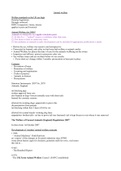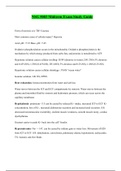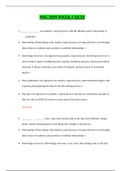Animal welfare
Welfare standards in the UK are high
Detailed legislation
Strongly enforced
RSPCA inspectors- farms, houses
applies to pets and livestock
Animal Welfare Act 2006*
Animals to which the Act applies (includes pets)
(1) In this Act …“animal” means a vertebrate other than man.
(2) Not those in fetal or embryonic form.
(3) Invertebrates or animals in early development can be included if appropriate justification is made.
• Before the act, welfare was reactive and retrospective
• Prosecuted or banned, only after we had seen bad welfare or animal cruelty
• Animal Welfare Act places the duty of care for the animals wellbeing on the owner
• Inspectors and officers- power to prosecute- plus vets
• See welfare issues and act on them before we see cruelty
• If you dont act/ change within 3 months- prosecution or bans put in place
Contents
- Prevention of harm
- Promotion of welfare
- Licensing and registration
- Codes of practice
- Animals in distress
- Prosecutions
Statutory Instruments 2007 No. 2078
Animals, England
tail docking pigs
written approval from vets
also banned in dogs- boxers normally seen with short tails
banned for cosmetic reasons
allowed for working dogs- paperwork to prove this
documentation from parents
tail docking within first 5 days of lift by vet
allowed for certain breeds- working dog lines
amputation- broken tails- vet has to prove tail was fractured- tail is kept frozen in vets where it was removed
The Welfare of Farmed Animals (England) Regulations 2007*
In force from 1st October 2007
Development of ‘modern’ animal welfare concerns
• 1964:
- ‘Animal Machines’: Ruth Harrison
an ‘expose’ of the changes in livestock industries since WWII
wrote about barren cages for chickens, gestation stalls for sows, veal crates
this led to…
•1965:
- The Brambell Report
•1979:
-The UK Farm Animal Welfare Council (FAWC) established
,Farm Animal Welfare Committee (FAWC)
An independent advisory body established by the Government in 1979.
Purpose:
to keep under review the welfare of farm animals on agricultural land, at market, in transit and at the place of
slaughter;
to advise the Government of any legislative or other changes that may be necessary.
Five Freedoms
Farm Animal Welfare Council 1979
By ready access to fresh water and a diet to maintain
Freedom from hunger and thirst
full health and vigour
By providing an appropriate environment including
Freedom from discomfort
shelter and comfortable resting area
Freedom from pain, injury or By prevention or rapid diagnosis and
disease treatment
Freedom to express normal By providing sufficient space, proper
behaviour facilities and company of the animal’s own kind
By ensuring conditions and treatment
Freedom from fear and distress
which avoid mental suffering
trade offs
some freedoms given higher priority
organic farms- more freedom to express normal behaviour- can come at a cost to other freedoms
Lives worth living?
Is the animal interested in things?
Does the animal take pleasure or enjoyment from things?
Real Welfare*
AHBD- voluntary scheme, farmers assure public they're doing best they can to give best welfare to animals
assured farms- vet goes 4 times a year to inspect any time, randomly select buildings and pens within to look
at
Scientifically validated measures of welfare that we can record by looking at the pig, not just measures of its
environment
,Involves on-farm assessment of pig welfare using a set of five objectives and repeatable measures which
are animal-based, meaning that they are obtained from the animals themselves, rather than from their
environment.
e.g. finisher pigs-criteria that they judge the animals against
Observed objective
1 Pigs with tail damage
2 Pigs with body marks (from fighting)
3 Lame pigs
4 Environmental enrichment provision and use
5 Pigs that would benefit fro remove to hospital pens
give score 4 times and overall score
vet can flag up issues
make recommendation for changes
check if changes have been put in place
Code of Recommendations for the Welfare of Livestock
The minimum requirements for farm animal welfare are laid out
E.g.:
• stocking density (how many animals in any pen, size of pen, who much space allowed for each animal in
pen)
• temperature
• lighting
• room at the trough- how many drinkers in a pen
• flow rate of water- depends on type of animal in pen
Transport
Welfare during transport is inversely proportional to the animal's worth.
LegislationsL
• type of vehicle
• how many animals on vehicle
• how long you're allowed to transport before offering food and water
• minimum and maximum temperature of wagon fro animal to be comfortable
anyone that transports animals has to sit an exam and be licensed to do so
Legislation:
Statutory Instrument 2006 No. 3260 The Welfare of Animals (Transport) (England) Order 2006
&
Council Regulation (EC) No 1/2005 of 22 December 2004 on the protection of animals during transport and
related operations and amending Directives 64/432/EEC and 93/119/EC and Regulation (EC) No 1255/97
Slaughter
Statutory instrument: 2001 No. 3830
ANIMALS, ENGLAND
PREVENTION OF CRUELTY, ENGLAND
, The Welfare of Animals (Slaughter or Killing) (Amendment) (England) Regulations 2012*
Legislations:
• which animals you're allowed to slaughter
• method of slaughter
• how animals are to be kept before slaughter
Humane Slaughter Association
The only registered charity that works, in the UK and internationally, through educational, scientific and
technical advances, exclusively towards the highest worldwide standards of welfare for food animals during
transport, marketing and slaughter.
Recent examples of work the HSA have been involved with include:
• Development of electrical methods for killing farmed fish
• Head-only electrical stunning systems for poultry
• Welfare of sheep and cattle passing through livestock markets
• Humane captive-bolt stunning of water buffalo
Farrowing Crates
sows can stand and sit and lie, roll side to side
cant tuen around in pen
bars give access to tests fro piglets
creep area-heat lamp- keep piglets warm
talk about banning
PigSAFE
Newcastle and Edinburgh university
feeding stall- sow fed in this
gate at back in which farmer can come in close gate behind sow and look at piglets whilst sow is eating
slatted dunging areas- first 7 days of birth- only accessible to sow
step in place between grey and white area- sow can get in, piglets cant
creep area- bars in front (sow cant lie in front) and roof on top- area only piglets can access, keeps piglets
warm, heat lamp or floor
barred areas- window for sow- contact with other sows
solid nest area- straw bedding, build nest, piglets with her
slopped walls- if sow lies down she's slopped against walls rather than on floor- lies down slower, gap
around the edge, if she lies down piglets gave got escape route than being squashed
pens are bigger than farrowing crates
means farmer cant have as many sows in their shed at one time
reduce productivity of farm- less piglets, less sows giving birth
sows loose- mortality increases- crushing piglets
360 Farrower
sow goes into crate
after 48 hours- bars open out act as slopped walls- sow has more room to move and turn around
protect piglets- lower mortality
Five freedoms
By giving her these cares that open up you are increasing her freedom to express normal behaviour
Reducing freedom from pain, injury or disease in piglets (crushed)
Beak trimming
EU Directive 99/74/EC lays down minimum standards for the protection of laying hens. This Directive bans
all mutilations but allows Member States to authorise beak trimming to prevent feather pecking and
cannibalism with certain provisos, e.g. that it is carried out by qualified staff and the procedure is done at less
than 10 days of age.
when chicks born, tip of beak is blunted by infra red
stop rather pecking






